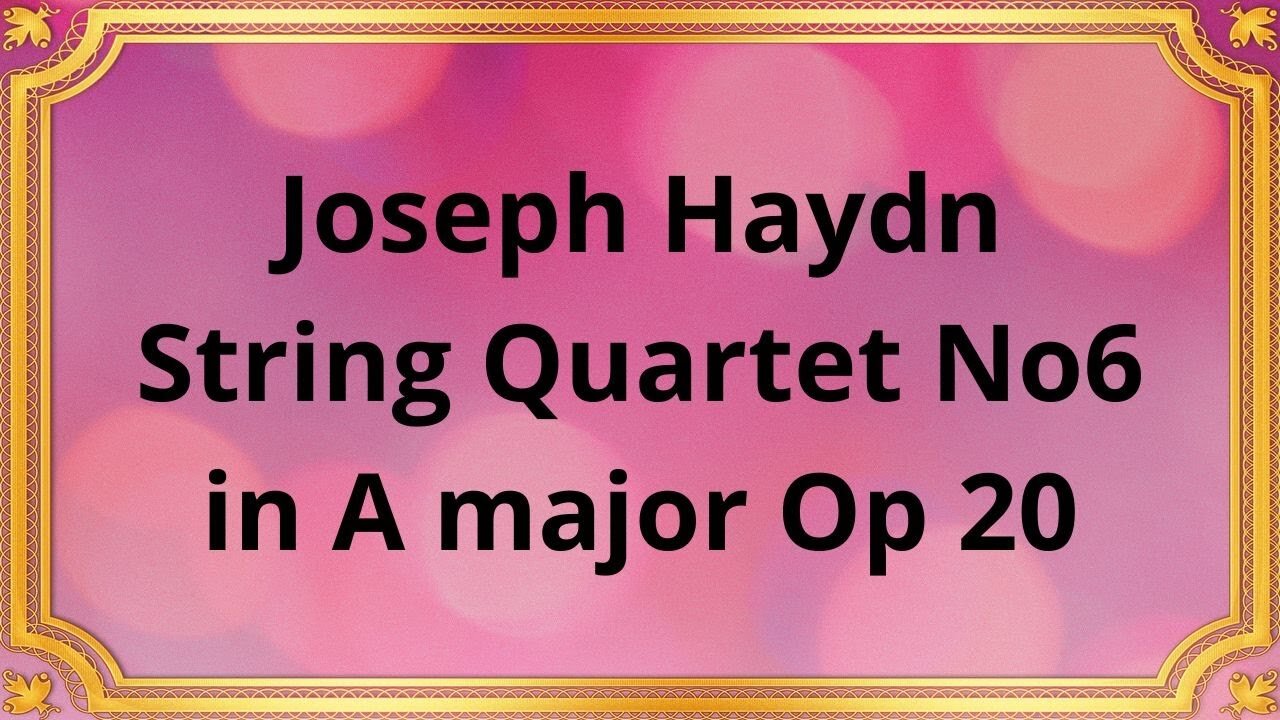Premium Only Content

Joseph Haydn String Quartet No6 in A major Op 20
#JosephHaydn #StringQuartet #Amajor #Op20 #classicalmusic #musicalcomposition #SunQuartets #historicalcontext #musicalcharacteristics #emotionalresonance #innovativeform #influentialcomposer
JOSEPH HAYDN COMPLETE STRING QUARTETS OF OP20
"The Sun Quartets"
Publication date 1952
SCHNEIDER QUARTET
Alexander Schneider, First Violin
Isidore Cohen, Second Violin
Karen Tuttle, viola
Madeline Foley, violoncello
Within the vast realm of classical music, certain compositions shine as timeless gems, and the "Joseph Haydn String Quartet No. 6 in A major, Op. 20" is undoubtedly one of them.
Composed in 1772, Joseph Haydn's String Quartet No. 6 in A major, Op. 20 is part of a set of six quartets known as the "Sun Quartets." These quartets were dedicated to Haydn's patron, Prince Nikolaus Esterházy, and they represent a significant milestone in Haydn's career. With this collection, Haydn pushed the boundaries of the string quartet genre, introducing innovative ideas and techniques that would influence generations of composers.
Haydn's String Quartet No. 6 in A major is a mesmerizing four-movement composition that showcases the composer's ingenuity and craftsmanship. The opening movement, marked Allegro di molto, bursts forth with exuberance and vitality. The quartet engages in a lively conversation, intertwining melodic lines and harmonies to create a rich tapestry of sound. Haydn's use of dynamic contrasts and rhythmic interplay adds depth and intrigue to this movement.
The second movement, marked Menuetto, presents a contrasting mood with its graceful and elegant character. This movement unfolds as a delightful dance, with Haydn's intricate melodies and rhythmic patterns captivating the listener's imagination. The quartet's seamless transitions and seamless unity of expression further enhance the enchanting atmosphere.
The third movement, marked Adagio, transports the listener to a realm of introspection and emotional depth. Haydn's gift for writing beautiful and expressive melodies is evident in this movement, as the quartet weaves a tapestry of profound beauty and contemplation. The quartet's nuanced phrasing and delicate interplay create an atmosphere of introspection and intimacy, evoking a range of emotions within the listener.
The final movement, marked Allegro, brings the quartet to a triumphant and exhilarating conclusion. It is a display of technical virtuosity, featuring rapid passages, intricate counterpoint, and vibrant harmonies. Haydn's mastery of form and structure shines through as the quartet navigates through moments of tension and resolution, building to a thrilling climax.
"Joseph Haydn String Quartet No. 6 in A major, Op. 20" is renowned for its ability to evoke a wide range of emotions within the listener. From the joyous and energetic moments to the introspective and contemplative passages, Haydn's composition strikes a chord with its emotional depth and resonance. The quartet's ability to captivate and move the listener is a testament to Haydn's profound understanding of human emotions and his skill in translating them into musical language.
Conclusion:
In conclusion, "Joseph Haydn String Quartet No. 6 in A major, Op. 20" is a testament to Haydn's genius as a composer. Its historical significance, musical characteristics, and emotional resonance make it a cherished work in the world of classical music. This quartet continues to captivate audiences with its innovative ideas, masterful craftsmanship, and ability to evoke profound emotions. Haydn's ability to push the boundaries of musical expression and create a harmonious tapestry of sound is a testament to his enduring legacy as one of the most influential composers in history.
You have the opportunity to support the channel:
https://destream.net/live/RadSiarAl/donate
https://www.buymeacoffee.com/6355radsiaral
-
 LIVE
LIVE
Game On!
1 hour agoPUMP THE BRAKES! Patrick Mahomes will NEVER be Tom Brady!
48 watching -
 1:04:14
1:04:14
In The Litter Box w/ Jewels & Catturd
22 hours agoBorder Is Closed | In the Litter Box w/ Jewels & Catturd – Ep. 726 – 1/23/2025
46.9K12 -
 1:41:52
1:41:52
The Quartering
4 hours agoDemonic Visitors, ICE Raids Begin, Brett Cooper Drama, Trump Vs Woke Bank, MSM Helping Illegals!
75.3K19 -
 1:53:38
1:53:38
Barry Cunningham
3 hours agoWATCH LIVE: TRUMP DAILY BRIEFING - PETE HEGSETH CONFIRMATION & NEW OTDERS BY PRESIDENT TRUMP
31.3K12 -
 1:08:57
1:08:57
Bare Knuckle Fighting Championship
21 hours agoBKFC KNUCKLEMANIA V PHILADELPHIA PRESS CONFERENCE | LIVE!
39K3 -
 2:11:55
2:11:55
vivafrei
6 hours agoTrump is Making Some BAD Decisions! More mRNA "Vaccine" Tyranny? Jan. 6 Release UPDATES! & More!
65.3K153 -
 2:17:45
2:17:45
Darkhorse Podcast
5 hours agoThe GOAT? The 261st Evolutionary Lens with Bret Weinstein and Heather Heying
26.8K26 -
 56:14
56:14
LFA TV
5 hours agoDEMOCRATS ARE PRO DEATH - BORN ALIVE ACT | LIVE WITH HANNAH FAULKNER 1.23.25 3pm
31.3K6 -
 LIVE
LIVE
Scammer Payback
5 hours agoCalling Scammers Live
423 watching -
 5:56:13
5:56:13
StormShadow127
6 hours agoPGA Tour 2K23 Leveling Up and Learning Greens.
29.4K2